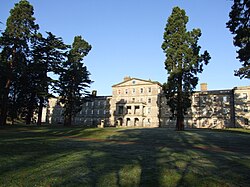Hospital in England
| Oakwood Hospital | |
|---|---|
 St Andrew's House, Oakwood Hospital St Andrew's House, Oakwood Hospital | |
 | |
| Geography | |
| Location | Maidstone, Kent, England, United Kingdom |
| Coordinates | 51°16′9″N 0°29′7″E / 51.26917°N 0.48528°E / 51.26917; 0.48528 |
| Organisation | |
| Care system | NHS England |
| Type | Psychiatric hospital |
| History | |
| Opened | 1833 |
| Closed | 1994 |
| Links | |
| Lists | Hospitals in England |
Oakwood Hospital in Barming Heath near Maidstone, England was a psychiatric hospital founded in 1833 as the Kent County Lunatic Asylum. Following transfer of services to Maidstone Hospital, Oakwood closed in 1994 and was then developed as a residential estate known as St Andrew's Park.
History
Construction and expansion
The Oakwood Hospital was founded as the "Kent County Lunatic Asylum" in 1833. It was designed as one building, commonly referred to as St Andrew's House, using an early corridor design by the surveyor to the County of Kent, John Whichcord Snr (who also designed Maidstone County Gaol). It was erected between 1829 and 1833 on a site in Barming Heath, just to the west of Maidstone. The asylum was intended to take in patients from across the entire county of Kent, which then stretched as far west as Greenwich. The first 168 patients were admitted in 1833.
As the asylum expanded, additions and extensions were made to this building until it had reached maximum potential capacity. In 1850 an additional building, known as The Queen's House, was built on newly acquired land at the site. This building was also designed by the architect John Whichcord Snr.
In the mid-nineteenth century, the superintendent of the asylum was Dr James Huxley (1821-1907), the elder brother of Thomas Henry Huxley, the evolutionary biologist and friend of Charles Darwin.
Further expansion took place between 1867 and 1872 with the building of the third asylum block (also known as the Hermitage Block).
On 29 November 1957, a fire broke out in the tailor's workshop on the first floor of one of the buildings. The fire brigade was called at 06:40 and arrived four minutes later. Six pumps attended and the 350 patients in that wing were evacuated. By 08:00 the fire was out, and the clearing-up process began. The block had been gutted but a 120-foot (37 m) tall ventilation tower seemed to have survived unscathed. At 10:00, the tower collapsed, killing three firemen, two nursing staff, the hospital printer and a patient and injuring a number of people.
Closure and redevelopment
Following the introduction of Care in the Community in the early 1980s and also the transfer of some services to Maidstone Hospital, Oakwood Hospital then became known as the Maidstone Hospital (Psychiatric Wing). The hospital closed completely in 1994. St Andrew's House, the Queen's House, the Beeches (formerly the Superintendent's House), and the two lodges were all Grade II listed buildings and so were all subsequently converted for residential use.
Gallery
-
 Rear of St Andrew's House 2000 – Photograph taken by Oxford Archaeological Unit.
Rear of St Andrew's House 2000 – Photograph taken by Oxford Archaeological Unit.
-
 Rear of St Andrew's House 2009
Rear of St Andrew's House 2009
-
 Detached Refractory Ward of St Andrew's House 2000 – Photograph taken by Oxford Archaeological Unit.
Detached Refractory Ward of St Andrew's House 2000 – Photograph taken by Oxford Archaeological Unit.
-
 Detached Refractory Ward of St Andrew's House 2009
Detached Refractory Ward of St Andrew's House 2009
-
 Front of St Andrew's House 2000 – Photograph taken by Oxford Archaeological Unit.
Front of St Andrew's House 2000 – Photograph taken by Oxford Archaeological Unit.
-
 Front of St Andrew's House 2009
Front of St Andrew's House 2009
Other notes
The word 'barmy' (meaning 'mad' or 'foolish') is popularly said to come from 'Barming' with allusion to the Hospital, but the Oxford English Dictionary records that it stems from the Old English word 'barm' meaning 'froth on fermenting malt'.
See also
References
Notes
- "Index of Lunatic Asylums and Mental Hospitals". www.studymore.org.uk. Retrieved 29 May 2011.
- ^ "Oakwood". County Asylums. Retrieved 10 October 2018.
- Ingleton, Roy (2010). Kent Disasters. Barnsley: Pen & Sword. pp. 18–20. ISBN 978-1-84563-116-1.
- ^ Gibbs, Rosie (16 December 2000). "Madhouse comes to its senses". The Telegraph. Archived from the original on 27 February 2016. Retrieved 10 October 2018.
- "Oakwood". Kent Messenger. 6 April 2017. Retrieved 10 October 2018.
- "Oakwood Hospital, Maidstone (Accident)". Hansard. 2 December 1957. Retrieved 10 October 2018.
- "St Andrew's House at Oakwood Hospital, Maidstone". www.britishlistedbuildings.co.uk. Retrieved 25 March 2012.
- "Queens House at Oakwood Hospital, Maidstone". www.britishlistedbuildings.co.uk. Retrieved 25 March 2012.
- "The Beeches at Oakwood Hospital, Maidstone". www.britishlistedbuildings.co.uk. Retrieved 25 March 2012.
- "Gate and Lodges of Oakwood Hospital, Maidstone". www.britishlistedbuildings.co.uk. Retrieved 25 March 2012.
- Tom Dalzell and Terry Victor (Editors) The Concise New Partridge Dictionary of Slang and Unconventional English, p. 1256, at Google Books
- Maurice Waite (Editor) Pocket Oxford English Dictionary, p. 65, at Google Books
Bibliography
- A History Of Oakwood Hospital 1828-1982 Kent County Council ISBN 0-905155-45-9
- Queen's House, Oakwood Hospital: Building Investigation Oxford Archaeological Unit 1998
- St Andrew's House, Oakwood Hospital: Historic Buildings Report Oxford Archaeological Unit 2002
- Archive collection held at the Centre For Kentish Studies in Maidstone
External links
Categories:- Hospitals disestablished in 1994
- Buildings and structures in Maidstone
- Defunct hospitals in England
- Former psychiatric hospitals in England
- Grade II listed buildings in Kent
- History of Kent
- Hospitals established in 1833
- Hospitals in Kent
- 1957 disasters in the United Kingdom
- 1957 fires
- November 1957 events in the United Kingdom
- 1833 establishments in England
- 1994 disestablishments in England